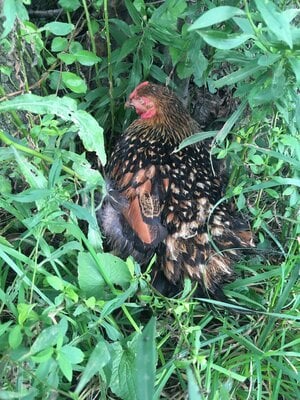Ohio peepers
Chirping
- Aug 25, 2018
- 25
- 37
- 61
Hello,
We have a golden laced Wyandotte whom I took to the vet in May after she presented with swollen abdomen and a penguin walk mid April (vet was closed until May due to Covid-19). Vet did paracentesis and said it could be cancer or liver, but that the chicken would end up dying. She gave us some meloxicam for comfort measures and said if I wanted to drain her at home I could. I and an oncology nurse and have had plenty of patients with ascites but I had never watched a paracentesis (thank you youtube!). Drained her every 4-7 days for about 3 weeks and then she didn't need it for awhile. The color was a reddish brown at first. Now the color is a dark green. She has lost a lot of weight. She eats very slowly and I assume she is getting closer to the actively dying process We love her dearly and she is a such a trooper as she has been sick for 5 months but now her quality of life is declining.
We love her dearly and she is a such a trooper as she has been sick for 5 months but now her quality of life is declining.
Does anyone know the difference in fluid color for chickens? For humans I know green is gallbladder.
her abdomen also feels hard and lumpy on the sides. I am assuming it is tumor formation, but I don't know.
I have attached a photo of before (the brown/red color) and the current color in a syringe.
Thank you!
We have a golden laced Wyandotte whom I took to the vet in May after she presented with swollen abdomen and a penguin walk mid April (vet was closed until May due to Covid-19). Vet did paracentesis and said it could be cancer or liver, but that the chicken would end up dying. She gave us some meloxicam for comfort measures and said if I wanted to drain her at home I could. I and an oncology nurse and have had plenty of patients with ascites but I had never watched a paracentesis (thank you youtube!). Drained her every 4-7 days for about 3 weeks and then she didn't need it for awhile. The color was a reddish brown at first. Now the color is a dark green. She has lost a lot of weight. She eats very slowly and I assume she is getting closer to the actively dying process
 We love her dearly and she is a such a trooper as she has been sick for 5 months but now her quality of life is declining.
We love her dearly and she is a such a trooper as she has been sick for 5 months but now her quality of life is declining.Does anyone know the difference in fluid color for chickens? For humans I know green is gallbladder.
her abdomen also feels hard and lumpy on the sides. I am assuming it is tumor formation, but I don't know.
I have attached a photo of before (the brown/red color) and the current color in a syringe.
Thank you!









